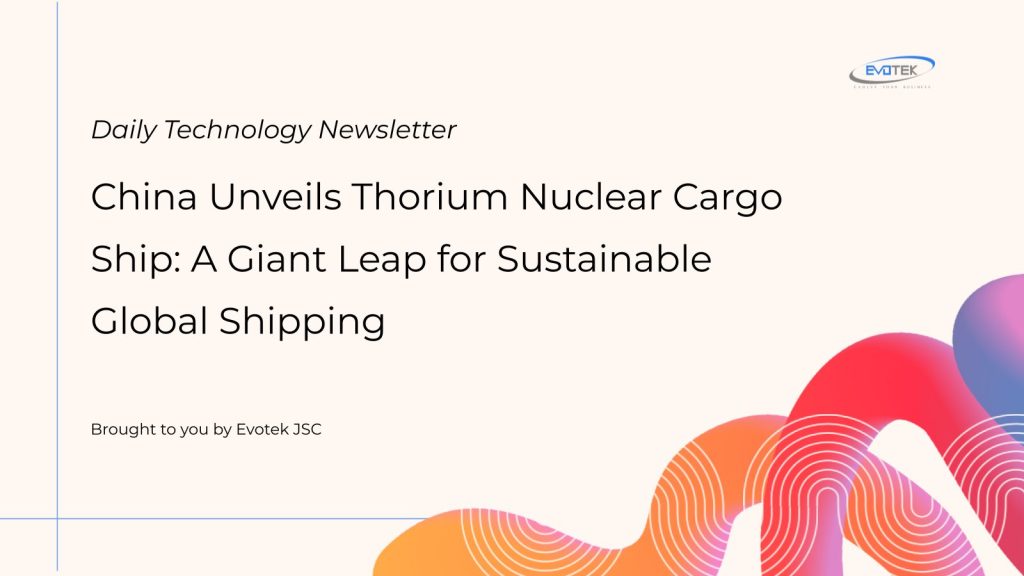China is set to revolutionize global maritime transport with the disclosure of crucial specifications for a massive nuclear-powered cargo vessel. This groundbreaking ship, designed to carry an astonishing 14,000 standard shipping containers, will be propelled by an advanced thorium-based molten salt reactor (TMSR), marking a significant stride in next-generation nuclear technology and sustainable shipping.
According to Hu Keyi, a senior engineer with the prominent Jiangnan Shipbuilding Group, the vessel’s propulsion system will harness a 200-megawatt thermal output. This power level is comparable to the formidable S6W reactors found in the US Navy’s advanced Seawolf-class nuclear attack submarines, highlighting the immense energy capabilities of China’s new maritime innovation.
Advanced Propulsion and Unprecedented Efficiency
While the ship’s concept was initially announced in 2023, technical specifics remained scarce until recently. Engineer Hu explained that the 200MW thermal output will not directly drive propulsion but will power a supercritical carbon dioxide (sCO2) generator utilizing the highly efficient Brayton cycle. This ingenious system will generate 50MW of electrical power, sufficient to propel the enormous vessel for years without the need for refueling.
A key advantage of this design lies in its exceptional energy conversion efficiency. The advanced sCO2 cycle achieves a remarkable thermal-to-electric conversion efficiency of 45 to 50 percent. This represents a substantial improvement over the approximately 33 percent efficiency typical of conventional steam-based reactors, paving the way for more energy-efficient and economically viable nuclear cargo operations.
Inherent Safety and Modular Design
The choice of thorium over traditional uranium as fuel provides a primary advantage in terms of inherent safety. Thorium is not only more abundant but the reactor design eliminates the need for water cooling, contributing to a smaller, quieter, and inherently safer system. Hu detailed multiple robust safeguards integrated into the reactor’s design:
- It operates at atmospheric pressure, completely removing the risk of explosive pressure build-up.
- The reactor boasts a strong negative temperature coefficient, ensuring the nuclear reaction naturally slows as temperatures rise, thereby preventing any runaway event.
- Two passive decay heat removal systems are in place. In an extreme emergency, the molten salt fuel would safely drop into a dedicated safety chamber and solidify, effectively trapping all radioactive materials.
Furthermore, the entire reactor unit is a sealed, modular system designed for a 10-year lifespan. After a decade of operation, the module is replaced as a whole rather than refueled on-site. This significantly reduces the risks associated with leaks and potential human error during refueling processes. A 10MWe diesel generator will also be on standby for any emergency power requirements.
China’s Ambitious Push Towards Nuclear Energy Leadership
The development of this advanced container ship is a cornerstone of China’s broader strategic initiative in advanced nuclear power. This endeavor follows a historic achievement in 2025, when China’s experimental thorium reactor in the Gobi Desert became the world’s first to attain long-term stable operation, conclusively proving the viability of this cutting-edge technology. Notably, the United States had discontinued its own thorium reactor program in the 1960s.
Leveraging its extensive domestic thorium reserves, particularly in Inner Mongolia, China is actively fueling this new generation of reactors. Engineer Hu also hinted at further explorations into other nuclear-powered vessels, including a Suezmax oil tanker equipped with a lead-bismuth cooled fast reactor and the development of floating nuclear power stations.
Recent breakthroughs have further solidified China’s position in thorium technology. The nation announced the successful first-ever conversion of thorium into uranium fuel within a Thorium Molten Salt Reactor (TMSR). This critical achievement offers concrete proof of the technical feasibility of utilizing thorium in a molten-salt reactor system, marking a pivotal milestone in the global development of next-generation, clean nuclear energy and affirming China’s leadership in sustainable maritime innovation.

 日本語
日本語 한국어
한국어 Tiếng Việt
Tiếng Việt 简体中文
简体中文